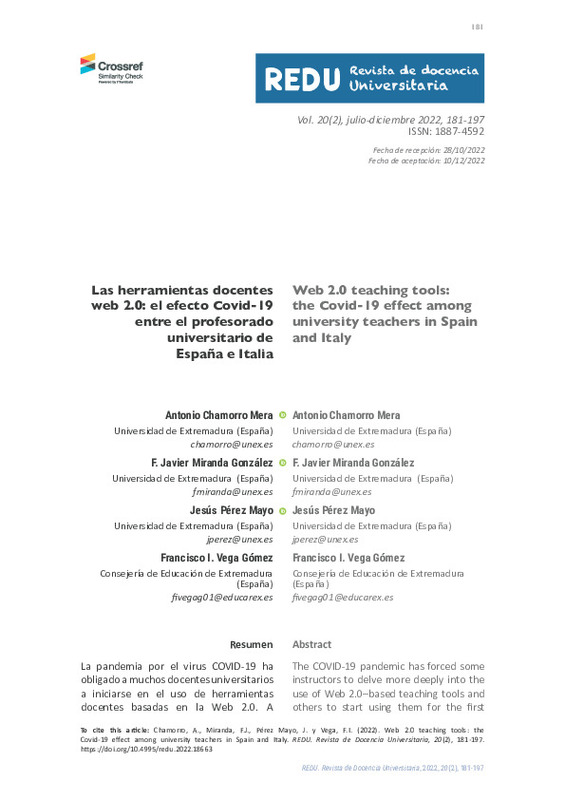Ajzen, I. (1991). The theory of planned behavior. Organizational behavior and human decision processes, 50(2), 179-211. https://doi.org/10.1016/0749-5978(91)90020-t
Aslan, A., Zhu, C. (2016). Influencing factors and integration of ICT into teaching practices of pre-service and starting teachers. International Journal of Research in Education and Science, 2(2), 359-37. https://doi.org/10.21890/ijres.81048
Backfisch, I., Lachner, A., Hische, C., Loose, F., Scheiter, K. (2020). Professional knowledge or motivation? Investigating the role of teachers’ expertise on the quality of technology-enhanced lesson plans. Learning and Instruction, 66, 101300. https://doi.org/10.1016/j.learninstruc.2019.101300
[+]
Ajzen, I. (1991). The theory of planned behavior. Organizational behavior and human decision processes, 50(2), 179-211. https://doi.org/10.1016/0749-5978(91)90020-t
Aslan, A., Zhu, C. (2016). Influencing factors and integration of ICT into teaching practices of pre-service and starting teachers. International Journal of Research in Education and Science, 2(2), 359-37. https://doi.org/10.21890/ijres.81048
Backfisch, I., Lachner, A., Hische, C., Loose, F., Scheiter, K. (2020). Professional knowledge or motivation? Investigating the role of teachers’ expertise on the quality of technology-enhanced lesson plans. Learning and Instruction, 66, 101300. https://doi.org/10.1016/j.learninstruc.2019.101300
Batsila, M., Vavougios, D., Tsihouridis, C., Ioannidis, G.S. (2014). Teachers’ attitudes towards the use of Web 2.0 tools in educational practice—A critical approach. In 2014 International Conference on Interactive Collaborative Learning (ICL) (pp. 464-472). Dubai. https://doi.org/10.1109/ICL.2014.7017817
Bennett, L. (2014). Putting in more: emotional work in adopting online tools in teaching and learning practices. Teaching in Higher Education, 19(8), 919-930. https://doi.org/10.1080/13562517.2014.934343
Buabeng-Andoh, C., Yaokumah, W., Tarhini, A. (2019). Investigating students’ intentions to use ICT: A comparison of theoretical models. Education and Information Technologies, 24(1), 643–660. https://doi.org/10.1007/s10639-018-9796-1
Butler, J.W. (2012). Grappling with change: Web 2.0 and teacher educators. In Developing technology-rich teacher education programs: Key issues (pp. 135-150). Hersey. IGI Global. https://doi.org/10.4018/978-1-4666-0014-0.ch010
Carril, P.C.M., Sanmamed, M.G., Abeledo, E.J.F. (2011). Competencias tecnológicas del profesorado universitario. Análisis de su formación en ofimática. Educación XX1, 14(2). https://doi.org/10.5944/educxx1.14.2.249
Elkaseh, A.M., Wong, K.W., Fung, C.C. (2016). Perceived ease of use and perceived usefulness of social media for e-learning in Libyan higher education: A structural equation modeling analysis. International Journal of Information and Education Technology, 6(3), 192. https://doi.org/10.7763/ijiet.2016.v6.683
González Robles, R., Polanco Bueno, R., Peñalosa Castro, E. (2021). Desarrollo de una escala de actitudes hacia el uso de las Tecnologías de la información y la Comunicación (TIC) en la actividad docente. Revista de la Educación Superior, 197, vol. 50, 97-116. https://doi.org/10.36857/resu.2021.197.1581
Habibi, A., Mukminin, A., Pratama, R., Harja, H. (2019). Predicting factors affecting intention to use web 2.0 in learning: evidence from science education. Journal of Baltic Science Education, 18(4). https://doi.org/10.33225/jbse/19.18.595
Huang, F., Teo, T., Zhou, M. (2020). Chinese students’ intentions to use the Internet-based technology for learning. Educational Technology Research and Development, 68(1), 575–591. https://doi.org/10.1007/s11423-019-09695-y
Kompen, R.T., Edirisingha, P., Canaleta, X., Alsina, M., Monguet, J.M. (2019). Personal learning Environments based on Web 2.0 services in higher education. Telematics and Informatics, 38, 194-206. https://doi.org/10.1016/j.tele.2018.10.003
Martín, A.H., de Arriba, J.M. (2017). Concepciones de los docentes no universitarios sobre el aprendizaje colaborativo con TIC. Educación XX1, 20(1), 185-208. https://doi.org/10.5944/educxx1.17508
Muhaimin, H., Mukminin, A., Pratama, R., Asrial, H. (2019). Predicting Factors Affecting Intention to use Web 2.0 in Learning: Evidence from Science Education. Journal of Baltic Science Education, 18(4), 595. https://doi.org/10.33225/jbse/19.18.595
Nikou, S.A., Economides, A.A. (2019). Factors that influence behavioral intention to use mobile-based assessment: A STEM teachers’ perspective. British Journal of Educational Technology, 50(2), 587–600. https://doi.org/10.1111/bjet.12609
Palmer, N., Schueths, A.M. (2013). Online teaching communities within sociology: A counter trend to the marketization of higher education. Teaching in Higher Education, 18(7), 809-820. https://doi.org/10.1080/13562517.2013.836097
Prasojo, L., Habibi, A., Mukminin, A., Sofyan, S., Indrayana, B., Anwar, K. (2020). Factors Influencing Intention to Use Web 2.0 in Indonesian Vocational High Schools. International Journal of Emerging Technologies in Learning, 15(5), 100-118. https://doi.org/10.3991/ijet.v15i05.10605
Rejón-Guardia, F., Polo-Peña, A.I., Maraver-Tarifa, G. (2019). The acceptance of a personal learning environment based on Google apps: the role of subjective norms and social image. Journal of Computing in Higher Education, 1–31. https://doi.org/10.1007/s12528-019-09206-1
Sadaf, A., Gezer, T. (2020). Exploring factors that influence teachers’ intentions to integrate digital literacy using the decomposed theory of planned behavior. Journal of Digital Learning in Teacher Education, 1–22. https://doi.org/10.1080/ 21532974.2020.1719244
Sadaf, A., Newby, T.J., Ertmer, P.A. (2012). Exploring pre-service teachers’ beliefs about using Web 2.0 technologies in K-12 classroom. Computers & Education, 59(3), 937–945. https://doi.org/10.1016/j.compedu.2012.04.001
Sadaf, A., Newby, T.J., Ertmer, P.A. (2016). An investigation of the factors that influence preservice teachers’ intentions and integration of Web 2.0 tools. Educational Technology Research and Development, 64(1), 37-64. https://doi.org/10.1007/s11423-015-9410-9
Sugar, W., Crawley, F., Fine, B. (2004). Examining teachers’ decisions to adopt new technology. Educational Technology & Society, 7(4), 201-213.
Teo, T. (2009). Modeling technology acceptance in education: A study of pre-service teachers. Computers & Education, 52(1), 302–312. https://doi.org/10.1016/j.compedu.2008.08.006
Teo, T., Sang, G., Mei, B., Hoi, C.K.W. (2019). Investigating pre-service teachers’ acceptance of Web 2.0 technologies in their future teaching: A Chinese perspective. Interactive Learning Environments, 27(4), 530–546. https://doi.org/10.1080/10494820.2018.1489290
Venkatesh, V., Rabah, J., Fusaro, M., Couture, A., Varela, W., Alexander, K. (2016). Factors impacting university instructors’ and students’ perceptions of course effectiveness and technology integration in the age of web 2.0. McGill Journal of Education/Revue Des Sciences de l’éducation de McGill, 51(1), 533–561. https://doi.org/10.7202/1037358ar
[-]









